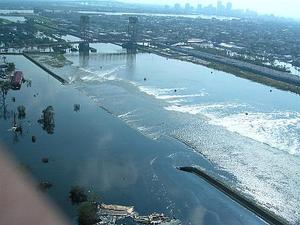DisastersDebate over causes of levee failure during Katrina intensifies
A court case in which residents of two sections of New Orleans are suing a construction group has put millions of dollars at stake; residents of the Lower 9th Ward and St. Bernard Parish residents claim that Washington Group International (WGI), an Amy Corps of Engineers contractor, removed several buildings and pilings from land along the Industrial Canal as part of a construction plan to expand the canal’s shipping lock, then failed adequately to plug the holes left behind; the holes allowed rainwater from Hurricane Katrina to seep underneath the 14-foot wall, essentially lifting the wall and allowing the areas to be flooded

Levee failure following hurricane Katrina // Source: rice.edu
A court case in which residents of two sections of New Orleans are suing a construction group has put millions of dollars at stake.
Attorneys representing a group of the Lower 9th Ward and St. Bernard Parish residents claim that Washington Group International (WGI), an Amy Corps of Engineers contractor, removed several buildings and pilings from land along the Industrial Canal as part of a construction plan to expand the canal’s shipping lock, then failed adequately to plug the holes left behind.
The Times-Picayune reports that the lawyers argued that the holes allowed rainwater from Hurricane Katrina to seep underneath the 14-foot wall, essentially lifting the wall and allowing the areas to be severely flooded.
Lawyers representing WGI blame the flooding on rainwater washing over the walls, which weakened the levees and caused the areas to be flooded
Robert Bea, a University of California at Berkeley engineering professor, a key witness in the trial, testified last week that the construction along the canal allowed the floodwater pressure to lift the wall from underneath. “Both breaches occurred crucially because of these uplift pressures,” Bea told the court.
Bea was the co-leader of a team of independent researchers that conducted a forensic investigation of failures of levees and floodwalls during the hurricane.
The Times-Picayune notes that lawyers representing the flooded residents had Bea on the stand for hours, but limited his testimony to a summary of his conclusions before allowing him to be cross-examined. Bea said that based on the evidence from his investigation, he rejected the theory that the floodwaters washed over the walls.
“I’m relying on the gift of those observations in the field,” Bea told the court. “That is validation in the real world.”
Defense attorney Bill Treeby started his cross-examination pointing to Bea’s testimony in previous legal proceedings. Treeby noted that Bea gave a “long list” of factors that contributed to the failures, including a tension crack along the wall.
Bea said that the failure of the walls required “multiple steps” in what he called a “stair-step to hell.” Bea also stated that without the impact of the construction by WGI, the walls would have kept the water out.
The Official Independent Performance Task Force, appointed by the Department of Defense after Katrina, concluded that the clay and peat layers beneath the wall held up during the hurricane, and that water seepage was not a factor in the flooding.
The Times-Picayune notes that the question of whether the levees were breached because water overtopped them, or due to water seeping under the levees, is at the heart of the case. The 1928 Flood Control Act gives the corps immunity from flooding caused by failure of its flood-protection projects such as dams, levees, and canals. Thus, if the two New Orleans wards were flooded as a result of water coming over the top of the levees, the corps and its contractor would be immune from damages.
The lock, however, is not a flood-control project, and is not related to such a project. Hence, if U.S. District Judge Stanwood Duval Jr. rules that work related to the lock helped cause the levee failures and subsequent flood, the corps and Washington Group International could be held liable for damage to thousands of homes in the Lower 9th and St. Bernard Parish.
Duval is hearing the case without a jury and has indicated that he is aware of the complex issues that are being presented in the case.
Last week Duval heard tearful testimony from residents in the flooded areas who lost their homes, memories, and much more due to the Hurricane. Duval has limited the trial to sixty days.
